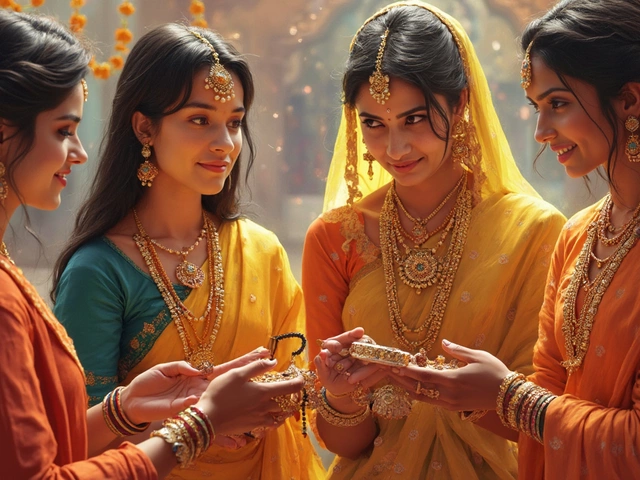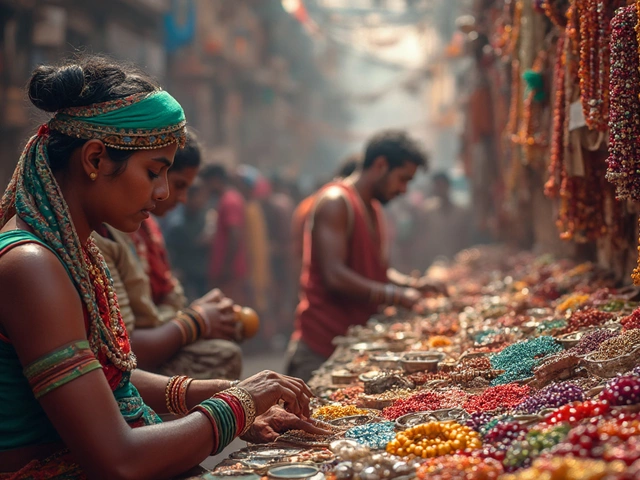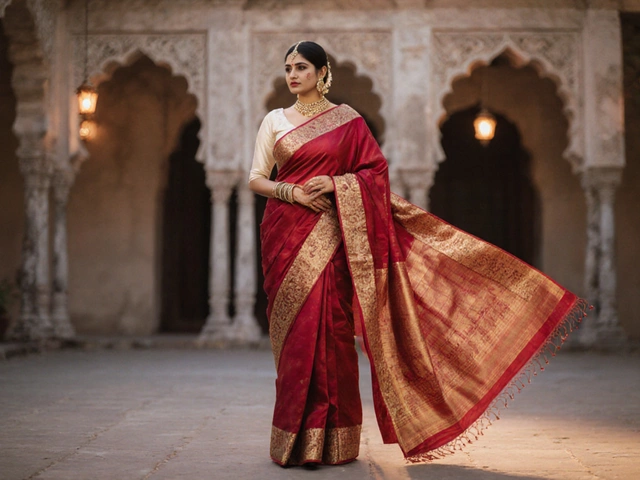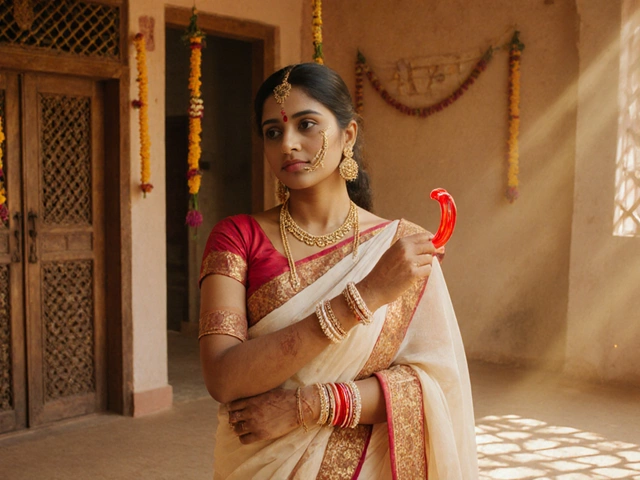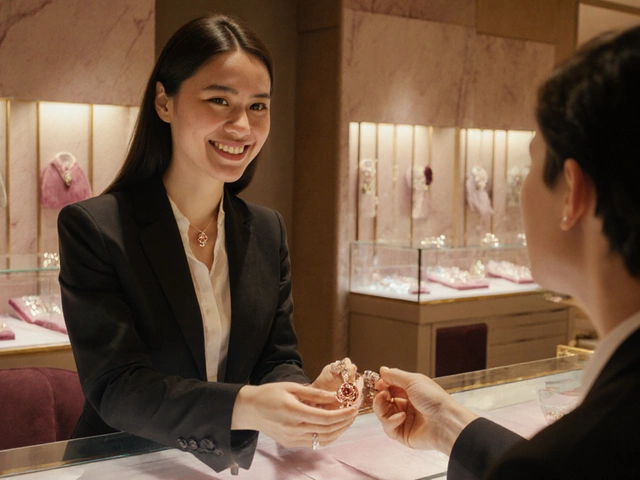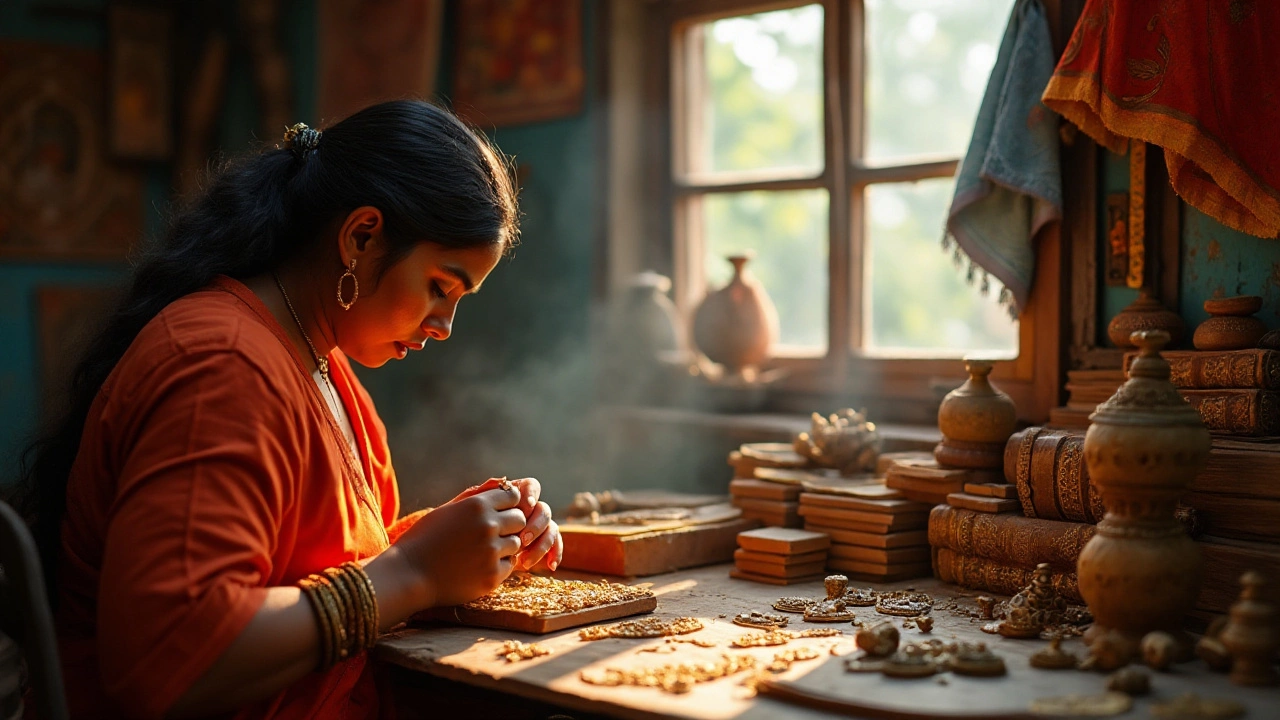
Steeped in tradition and spiritual significance, Vedic jewellery stands as a captivating fusion of art and devotion. These pieces, often associated with sacred environments like temples, have been treasured throughout Indian history for their intricate craftsmanship and profound symbolism.
Each element crafted in these jewellery pieces tells a story or serves a purpose that transcends mere adornment. They are designed to channel positive energies, protect the wearer, and reflect the rich tapestry of Indian spirituality and culture. Whether it's the glint of gold or the sparkle of precious stones, Vedic jewellery is more than just decorative finery; it's a journey into the heart of cultural artistry and belief.
- The Origins of Vedic Jewellery
- Symbolism and Spiritual Significance
- Craftsmanship and Materials Used
- Vedic Jewellery in Modern Times
- Caring for Your Vedic Ornaments
- Where to Find Authentic Pieces
The Origins of Vedic Jewellery
The allure of Vedic jewellery is deeply rooted in ancient Indian history, tracing back over thousands of years. Its origins are intimately connected to Hindu religious practices and the early Vedic texts, which served as a guide for life's spiritual journeys. These texts, known as the Vedas, are a rich source of knowledge and philosophy, and they mention jewellery as not merely decorative but as an emblem of spiritual harmony and protection.
In ancient India, jewellery was a significant part of religious rituals and adorned on sculptures of deities within temples. The tradition of making temple jewellery, richly detailed and imbued with spiritual meaning, emerged during the early centuries BCE. During this time, the art was honed by skilled artisans who saw their work as more than craftsmanship—it was a sacred duty. The designs were inspired by the natural world and the symbolic motifs of animals and plants, believed to hold spiritual powers. These designs became a medium through which people could express their connection to the divine.
The precious metals such as gold, revered for its purity, and stones like rubies and emeralds, noted for their auspicious properties, were integral in creating these opulent pieces. Gold, in particular, held a unique place due to its unchanging nature, symbolizing immortality and endurance. An interesting fact is that famed texts like the Ramayana and Mahabharata mention luxury and temple jewellery, suggesting their significance in the ancient socio-religious contexts as a status of wealth and divine blessing.
Some scholars argue that the intricate designs of ancient Indian jewellery were influenced by the socio-economic conditions and advancements of the time. For instance, the abundance of mines during the Mauryan Empire contributed to the proliferation of both precious metals and stones. Noted historian Romila Thapar once remarked,
The lavish jewellery seen in temple relics reflects not only artistic excellence but also the prosperity and resources of the period.
These early designs laid the foundation for Indian jewellery making, influencing countless eras and regions. The legacy of this magnificent craft is not only preserved in material form but also in its transmission through generations of artisans who still use age-old techniques. Today, as you step into the traditional jewellers' spheres across India, you can witness these time-honored methods blended with the whispers of historical opulence.
Symbolism and Spiritual Significance
Ancient civilizations have always embedded symbolism into their art, and Vedic jewellery is no exception. Beyond the dazzle of its gold and the sparkle of its stones, each piece is steeped in profound meanings that resonate with Indian spirituality and beliefs. Vedic jewellery does not merely beautify; it serves as a conduit for divine energies. Historically, each ornament was thoughtfully crafted to align the wearer's energies with cosmic forces, enhancing prosperity, protection, and peace.
The designs themselves are rich in sacred symbolism. For instance, the lotus, frequently featured in Vedic jewellery, represents purity and spiritual enlightenment. Similarly, the peacock, often rendered in vivid detail, is a symbol of grace and continuity. The serpentine forms bring to mind the Kundalini energy, believed to coil at the base of the spine and awaken enlightenment as it rises. Wearing these symbols is thought to invoke the attributes they represent, endowing the bearer with unique spiritual resonance.
"Jewellery was not just an accessory; it was a way of life. Every piece worn by the women had a story, a significance that transcended its physical presence," notes historian Dr. Rajamannar Venkatesan in his celebrated work on Indian craftsmanship.Deities hold a central place in Vedic jewellery design, as well. With forms and motifs that echo the divine, adornments often incorporate depictions of Hindu gods and goddesses, designed to evoke the wearer’s proximity to the divine and secure their blessings. Intricate carvings of Lakshmi, the goddess of wealth, or Ganesha, the remover of obstacles, are frequently seen, making these jewellery pieces not just beautiful artifacts but sacred amulets.
The spiritual significance also extends to the selection of materials. Gold, predominant in temple jewellery, represents the sun, the life force, embodying wealth and purity. Silver, too, is celebrated for its connection to the moon, invoking tranquility and strength in the wearer. Gemstones are chosen for their metaphysical properties; sapphires for intuition, emeralds for growth, and diamonds for invincibility. Wearing these gemstones is akin to harnessing their inherent powers to influence one’s life positively.
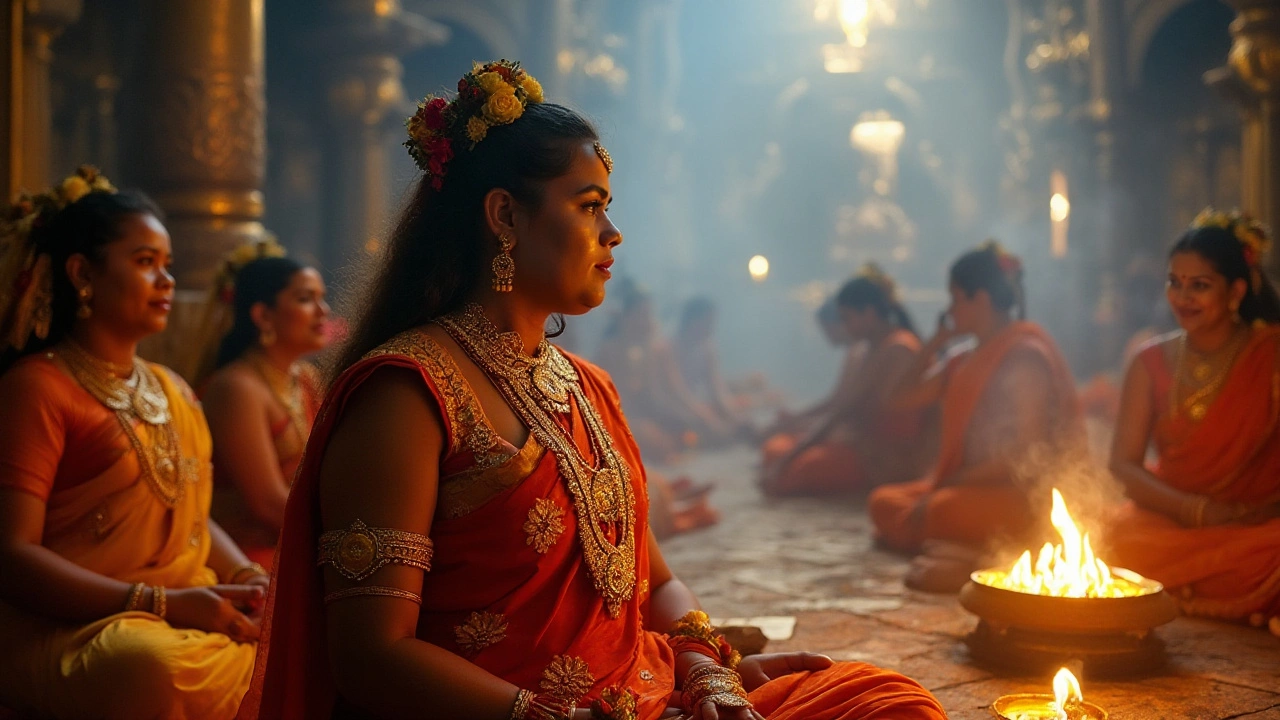
Craftsmanship and Materials Used
The creation of Vedic jewellery involves a meticulous process that not only showcases the artistic diligence of Indian artisans but also underscores the deep cultural significance embedded within each piece. This artistry is a legacy passed down through generations, where each craftsman plays a vital role in preserving centuries-old traditions. The detailed work typically begins with the selection of materials, which is crucial as these pieces are designed to last for generations and also carry spiritual significance.
Gold is often the primary metal used in making temple jewellery, chosen not only for its durability but also for its auspiciousness in Indian culture. It symbolizes prosperity and purity, believed to attract positive energy and blessings from the deities. Artisans may also use silver, revered for its purity and often considered to have protective properties. Precious stones such as rubies, sapphires, and emeralds are frequently used, each selected for its specific symbolism and beauty. It's these stones that add vibrant colors and additional layers of meaning to the jewellery.
The intricacies of the craftsmanship are astonishing. Traditionally, the lost-wax casting technique is employed to achieve the ornate designs typical of Indian jewellery. This ancient method involves creating a detailed wax model which is then encased in a mold. Once the wax is melted away, molten gold or silver is poured in to form the final piece. Each of these steps is performed with the utmost precision to ensure the design’s fidelity and the jewellery's integrity. The mastery required for this process is a testament to the artisan’s skills and the cultural heritage that underpins their craft.
"True art and technique are the soul of temple jewels, where devotion meets precision," explains Dr. Meenakshi Iyer, a historian specializing in Indian art and culture.
In modern times, this dedication remains strong. Artisans often train for years to perfect their skills, taking pride in their ability to bring to life the ornate patterns that are symbolic and carry profound spiritual meanings. The blend of traditional techniques and contemporary designs not only preserves the ancient craftsmanship but also appeals to modern aesthetics. This unique ability to adapt while maintaining heritage standards is what keeps Vedic jewellery in the hearts and wardrobes of people around the world.
Collectively, these elements result in a form of jewellery that is much more than decorative. It embodies a philosophy and a way of life, capturing the essence of spirituality, artistry, and tradition. Each piece tells a story, crafted with the intent to honor the divine forces and the rich tapestry of Indian culture.
Vedic Jewellery in Modern Times
In a world constantly advancing towards the digital and the modern, the charm of Vedic jewellery continues to captivate those who cherish tradition and spirituality. This ancient art form finds itself not only surviving but thriving, resonating with a new generation that craves authenticity amidst manufactured sameness. Celebrities, designers, and cultural connoisseurs have played a pivotal role in reviving and reimagining these precious trinkets, effectively bridging the past and the present. The intricate designs, which have been meticulously passed down through generations, now see a rebirth in contemporary wardrobes, proving that the allure of Vedic jewellery is truly timeless.
The renowned designer Sabyasachi Mukherjee once remarked, "In a world where people can be cyber personalities in seconds, there's a yearning for the physical touch of history in something as tangible and beautiful as jewellery."
One cannot ignore the fact that Indian jewellery has been embraced by global fashionistas. This acceptance has led to its prominent appearance in high-profile settings like international fashion shows and red-carpet events. The elements that define Vedic pieces, like the generous use of gold and the detailing in gemstones, are noted for their ethereal beauty and spiritual weight. These pieces not only assert cultural heritage but also bring a sort of mystical allure, which seems to enthrall audiences across the world. And while the essence remains untouched, there are subtle innovations that adapt these pieces for modern aesthetics — lighter weights, minimalist forms, and cross-cultural integrations.
Modern wearers of temple jewellery, both men and women, find that these pieces offer more than adornment. They are often perceived as talismans that carry protective energies, embedded with symbols that represent divine figures or natural elements. The connection many feel with Vedic jewellery is personal and profound, as these pieces often accompany significant life events like weddings, births, or religious ceremonies. It's no wonder that people are drawn to them for their beauty and perceived blessings, ensuring their continued relevance.
In today's fast-paced lifestyle, there's also a growing appreciation for sustainable and ethical fashion, and Vedic jewellery fits into this ethos perfectly. Many pieces are handmade by skilled artisans, promoting traditional crafts that might otherwise fade into obscurity. This method of production not only supports local craftsmanship but also offers consumers a genuine product steeped in history. These factors align contemporary values with heritage, creating a demand that sustains and enriches artisan communities.
With the advent of digital marketplaces, acquiring genuine temple jewellery has become easier than ever. Online platforms showcase artisan stories and the journey of each piece, adding layers of context and connectivity for potential buyers. This setting allows stories to thrive and travel, making the rich heritage that temple jewellery carries more accessible to a global audience who may only experience it through online galleries or curated collections. As the world progresses, Vedic jewellery's story continues to be told, cherished, and worn, ensuring its legacy endures for many more years to come.
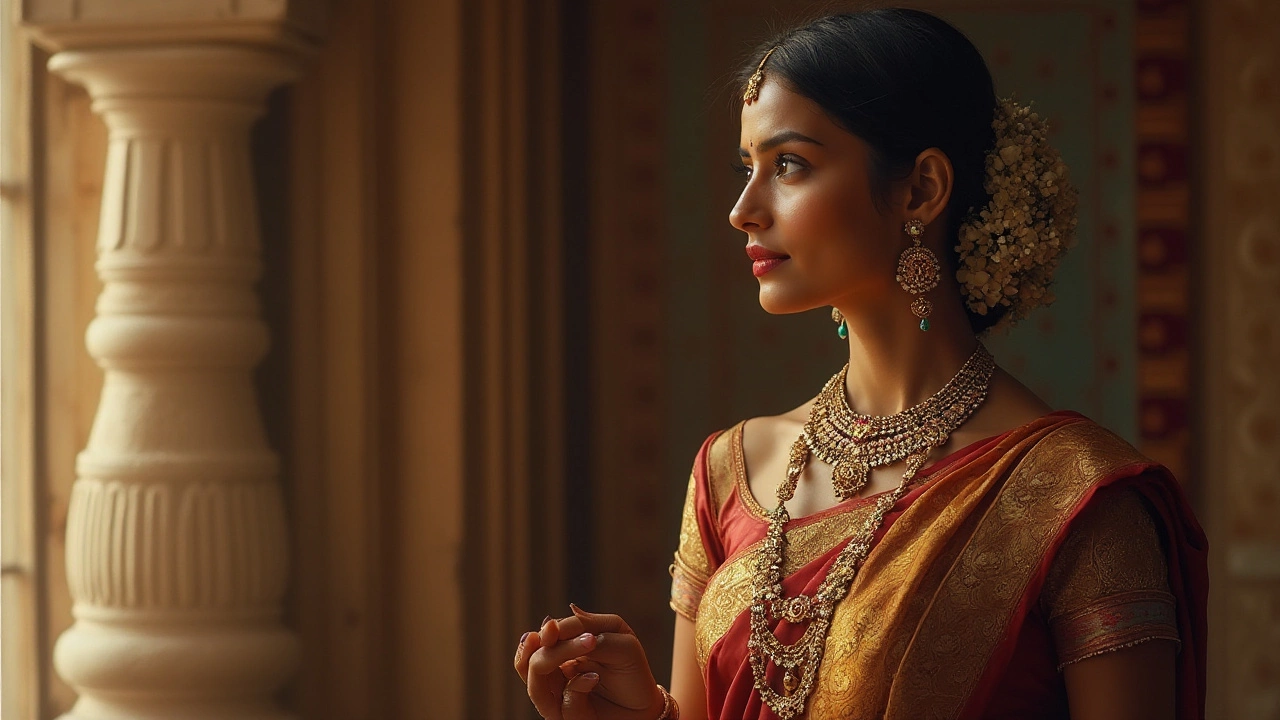
Caring for Your Vedic Ornaments
Caring for your Vedic jewellery is crucial to preserve its unique blend of artistry and spiritual symbolism. As these pieces often contain precious metals and stones, they require specific maintenance techniques to retain their lustre and sanctity. Start by routinely cleaning the jewellery with a soft cloth to remove any accumulated dust or sweat. Occasionally, gently wash them with mild, soapy water, ensuring not to soak the pieces for too long, as this could damage any embedded stones or intricate filigree work. It's equally important to dry them thoroughly with a cloth to prevent water spots or residue, which might impact the metal's sheen over time.
An effective way to ensure that your temple jewellery remains vibrant is to store each piece separately in a soft pouch or lined box. This prevents scratches and tangling, especially with delicate chains or pieces featuring intricate carvings. Avoid exposing these sacred pieces to harsh chemicals like perfume or hairspray, which can tarnish metals and dull the shine of precious stones. If possible, don the jewellery after you've applied cosmetics and styling products. Regular inspections for loose settings or weakened clasps can help avoid accidental loss or damage to valuable components.
As a traditional practice, some caretakers suggest following the moon cycles when it comes to the cleaning of spiritually significant ornaments. While there are no scientific validations, some believe that cleaning your Vedic ornaments on a full moon imbues them with additional energy. According to artisan and jewellery expert Rekha Jain, "Treating these ornaments with respect not only preserves their physical beauty, but also helps maintain the spiritual energy they are believed to carry."
"The meticulous craft and spirituality imbued in each piece make them not just decorative, but a testimony of faith and cultural heritage," says Jain.
Should your Indian jewellery require more intensive restoration, consulting a professional jeweller experienced with traditional pieces is advisable. They possess the skills to mend any intricate details that may have worn away with time. Additionally, it's worth considering a yearly check-up for your pieces to ensure all components remain secure. This not only helps keep the jewellery in impeccable condition but also respects the cultural and spiritual heritage they represent. Beyond aesthetics, caring for your jewellery is intertwined with respecting and honouring the culture from which it hails, making your pieces truly timeless.
Where to Find Authentic Pieces
Discovering genuine Vedic jewellery is an adventure that takes you through the vibrant lanes of Indian culture, both historically and in modern times. If you're on a quest for authenticity, there's no better place to start than the bustling local markets of Jaipur and Chennai. These cities are renowned hubs for exquisite temple jewellery, where skilled artisans have been perfecting their craft for generations. In Jaipur, the legendary Johari Bazaar glimmers with all that’s traditional and treasured, while Chennai's thriving gold markets offer pieces that echo ancient artistry and sacred devotions.
For those who cannot travel, India's craftsmanship comes to life through specialized online platforms that bring these timeless pieces right to your doorstep. Websites like CaratLane and Tanishq offer authentic collections that highlight distinct traditional designs, providing a digital gateway to a world where each piece tells a story. These platforms ensure the quality and authenticity of their treasure troves, making traditional beauty accessible to the global collector.
In larger cities, speciality stores nestled within cultural districts also offer extraordinary varieties of Vedic jewellery. They often function as hidden gems, preserving the essence of this craft amidst a modern setting. These stores often host exhibitions or workshops, showcasing the in-depth process of making such jewellery, providing not only a purchase but an experience of cultural immersion. A true aficionado of Indian jewellery would appreciate visiting one of these workshops to witness and even partake in the intricate processes.
"The significance of each piece goes beyond the glitter," says Radhika Sinha, a curator of traditional Indian arts. "It’s like holding a piece of history, where every color and motif hides a spiritual story ready to be unfolded through time and tradition."
Travel enthusiasts might also find pilgrimage towns brimming with small shops and stalls that offer handcrafted pieces, often blessed at local temples. Rishikesh and Varanasi, for instance, are two such destinations where spirituality seamlessly intertwines with craftsmanship, providing seekers not only with jewellery but with symbols of their faith and an enduring legacy.
Given the prominence of spiritual adornments, festivals like Diwali and Navratri offer the best opportunity to explore the surreal world of Vedic jewellery. During these festive seasons, many large and small-scale jewellery fairs take place, providing an exquisite stage for artisans from various regions to showcase their craft. Attending one such fair allows you to absorb the festive essence and marvel at the diverse offerings that resonate with people seeking spiritual and aesthetic pleasures alike.

